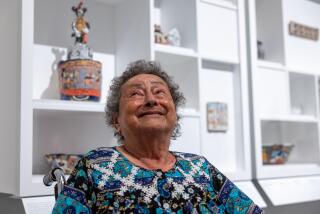ART REVIEW : GOLDEN AGE PIECES ARE WORTH PEEK
- Share via
SAN DIEGO — For its seventh annual Spring Exhibition, the San Diego State University Art Council is presenting “Joan Brown: The Golden Age.” The colorful paintings and sculptures include representative works from the artist’s career since 1981. “The Golden Age” of the title refers not to this period but to the content of many of Brown’s works that refer to a new age, the Aquarian Age, celebrated some years ago in the musical “Hair.”
Brown, who, coincidentally, was born in 1938 under the astrological sign of Aquarius, a water sign, and who is passionately devoted to daily swimming in San Francisco Bay, has commented: “The ancient cultures, as well as the prophets throughout the ages, have foretold that a Golden Age will recur. It will be a peaceful time when all creatures on earth will live in perfect harmony. We are now at the dawn of this Golden Age, which is the Aquarian Age.”
Brown joins a respected tradition of visual artists and writers who since antiquity (and, for all we know, prehistory) have limned idyllic visions of past and future paradises. Most important among these, for North Americans, is “The Peaceable Kingdom” painted often by early 19th-Century naive Quaker artist Edward Hicks, to which Brown alludes in several of the exhibited canvases.
As a student at the California School of Fine Arts, now the San Francisco Art Institute, Brown was regarded in the late 1950s as a wunderkind. Not only was she an exceptionally strong artist in combining abstract expressionist handling of paint with figuration, she was a woman able to hold her own, and more, in a milieu dominated by aggressively male artists. With works from this period and later years, she established her position in American art history. She is represented by works in major museums throughout the United States, including the Museum of Modern Art and the Whitney Museum of American Art in New York. Her furred sculpture “Rat Fink” is an iconic representation of Bay Area Funk.
Brown has retained the human figure as her focus of interest and has increasingly (as has Robert Arneson, also of the Bay Area) made self-portraits, not as narcissistic statements of self-fascination but rather as serial reflections of the world we inhabit. In the late 1960s and early 1970s her dancing figures and ocean liner passengers seemed to allude to the Dance of Death and the Ship of Fools. She also made many paintings and sculptures (cardboard was a favorite material) of women swimming. What was ostensibly a pleasurable activity could also be interpreted as a struggle to survive and as the isolation of the individual, as well as a desire for union with the universe (“that oceanic feeling”).
She eschewed the heavy impasto, the expressionism and the ambiguity of her early days and painted instead assertive compositions with large areas in flat color and patterned embellishments. Her works were distinctive, sometimes amusing, sometimes alarming, often haunting, always impressive.
In 1977 Brown traveled to Egypt. Since then she has traveled to Ecuador and Peru, China, India, Mexico and elsewhere. Her works of the last decade, reflecting her encounters with the cultures of the places she has visited, are a spiritual autobiography.
Visitors to the SDSU Art Gallery will see self-portraits with appropriate visual references --images of gods and goddesses with other symbols--in homage to Akhnaton (a 14th-Century B.C. pharaoh who attempted to impose monotheism in Egypt), Quetzalcoatl (principal god of the Aztecs, usually represented as a feathered serpent) and Sathya Sai Baba, the artist’s teacher in India. Brown has also portrayed herself against a solid blue field filled with astrological symbols.
In all the self-portraits the artist’s disheveled bright red hair and staring blue eyes are unforgettable.
Other works, including a series of “Bathers,” referring to the artist’s fascination with water, are among the strongest in the show, truly revealing Brown’s mastery of her art. Brown’s sensual paintings are, ironically, more evocative than her spiritual paintings.
Finally, the series of paintings and sculptures called “The Peaceable Kingdom,” with paired representations of a lion and a lamb, a peacock and a snake, for example, are, for all the sincerity of the artist’s intent, trivial works of art, unworthy of Brown, as is the Horton Plaza obelisk that she designed and that motivated the SDSU Art Council to sponsor this exhibition.
But the show is worth seeing for the beautiful and engaging works of art it includes. It continues through May 15.
More to Read
The biggest entertainment stories
Get our big stories about Hollywood, film, television, music, arts, culture and more right in your inbox as soon as they publish.
You may occasionally receive promotional content from the Los Angeles Times.










